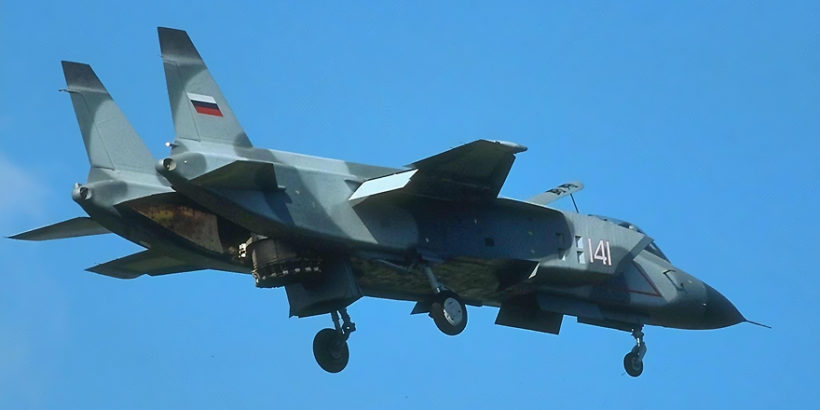On 9 March 1987 the Yak-41 prototype vertical take-off and landing (VTOL) fighter made its maiden flight. The leading test pilot Andrei Aleksandrovich Sinitsyn took the airplane into the sky.
Yakovlev Design Bureau had been working on the VTOL aircraft since the late 1950s. In 1961, the design of Yak-36 was determined, the flight tests of which began two years later. The deeply modernized Yak-38 went into production. But in the first half of 1970s it became evident that the Yak-38 characteristics did not meet the fleet requirements: it had a short range and small payload, was subsonic, had no onboard radar station.
On June 26, 1974, a directive of the CPSU Central Committee and the USSR Council of Ministers was issued, which officially launched the development of a new VTOL fighter and set a deadline for the submission of the finished project. At the early stage it was supposed to use a single propulsion system with a single lift-marshalling engine (PMD) of 15 000 kgf thrust. The first full-size mock-up of the aircraft was assembled. But already during the work on it, it became clear that the machine with such a layout would be almost impossible to stabilize in vertical flight modes. The State Commission, having familiarized itself with the mockup, came to the same conclusions. Therefore, it was decided to switch to a combined propulsion system, the experience of building and operating which had already been obtained on the Yak-38.
In 1975 the projected aircraft received the Yak-41 index and the internal designation “item 48”. Another directive of the Central Committee and the Council of Ministers, which came out on November 11, 1977, instructed the Yakovlev Design Bureau and the Soyuz AMSTC to develop, respectively, the Yak-41 air-to-air carrier-based fighter and the R79V-300 PMD for it. The directive contained a list of basic requirements for them, as well as a deadline for submitting the aircraft for state tests – 1982.
But arising technological difficulties did not allow to meet the deadline. One of the main problems was the development of a rotary nozzle for the PMD. Initially, AMSTC Soyuz was working on a variant with a flat two-axis nozzle, but because of the lack of experience in this area, it was decided to switch to the traditional axisymmetric nozzle. For its rotation, an original solution was used – the nozzle was divided into three segments, which, rotating in opposite directions relative to each other, provided deflection of the thrust vector in the vertical plane to an angle of 95° (it was used during the VTOL). For short takeoff, the nozzle was moved to the 62° position. This solution made it possible to use afterburner in both horizontal and vertical modes.
Due to delays in nozzle development, the order was issued on 25th November 1983 postponing the state tests of Yak-41 until 1985. Tests of the engine on the flying laboratory started in August 1984. And only in February 1987, the specialized institute issued a permit for the first flight of the first fighter prototype. In the same year was built and the second prototype, its tests began in 1989. At the same time, due to schedule delays, the designation of the machine was changed to Yak-141.
In 1991, 12 world records were set on the Yak-141, and test flights from the heavy aircraft cruiser Admiral Gorshkov also began. Alas, in October 1991, the second prototype crashed. Against the background of worsening economic problems in the country, it was decided to close the project.


